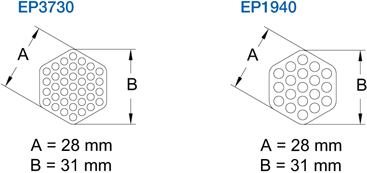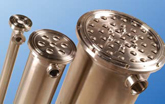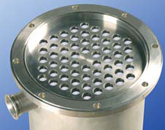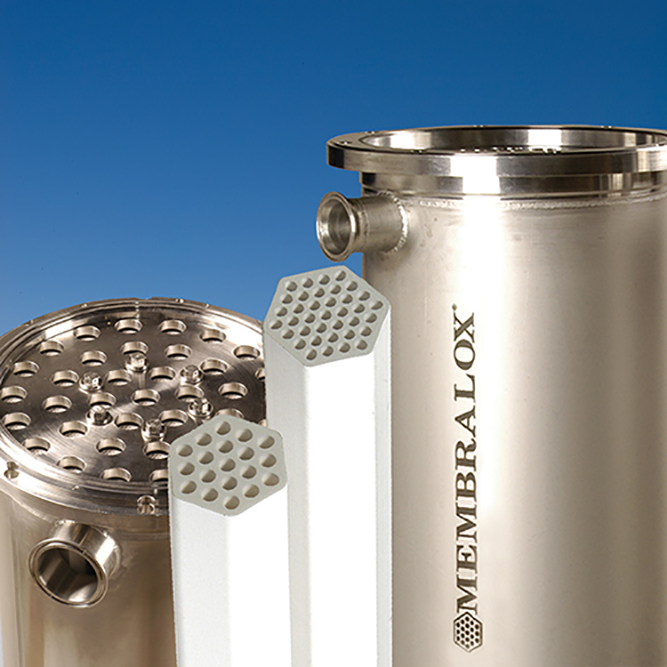Efficient Control of Microfiltration
Regime for Higher Performances
The Pall Membralox GP membrane is designed for optimum soluble macromolecules transfer across the microfiltration membrane. In conventional microfiltration conditions, the natural pressure drop creates asymmetric transmembrane pressure (TMP) from the inlet to the outlet of the flow channel. To correct this TMP decrease, Membralox GP membranes have a longitudinal permeability gradient built into the support structure without modification of the filtration layer. This design ensure a stable microfiltration regime all along the membrane. Features
- Precisely calibrated flux
- Controlled selectivity all along the membrane
- Hydrodynamically optimized
- Proven long operational life
- Meet the requirements for food usage1
- Fitted in standard housings
- Uniflow directional membranes
- Customized membrane configurations can also be proposed for the most stringent applications
Increased Productivity
- Significant increase in yield
- Extended shelf life of filtered solutions
- Selective separations between macromolecules
- Selective fractionation of complex products
- Reliable performances, longer service life, longer processing times
1The membranes based on high purity alumina are certified for use in contact with food fluids by Commission Directive 2005/31/EC. All membrane components are made from materials that our suppliers state meet the requirements for food contact use: Alumina and titania are GRAS. Zirconia layers on alumina support are listed in 21 CFR Sect.177.2910.
Comparison of Flux Profiles in Standard Crossflow
Microfiltration and Membralox GP Crossflow Microfiltration

Pall Membralox GP Ceramic Membranes Configurations

| GP Membrane Type | EP3730 | EP1940 |
| Channel Diameter (mm) | 3 | 4 |
| Number of channels | 37 | 19 |
| Filtration surface area (m2) | 0.35 | 0.24 |
| Length (mm) | 1020 | 1020 |
Membralox GP Membranes Pore Sizes and Calibration Range
| Pore size | Calibration | |
| Microfiltration | 1.4 μm, 0.8 μm | 500 l/h.m2 |
| 0.1 μm, 100 nm | 100 l/h.m2 | |
Other pore sizes and calibration available on request.
Membralox SD 3-A Modules

| Module Type | No. of Membranes | Membrane Type | Surface Area (m2) | Retentate Connections (RC) Permeate Connections (PC) |
| M-1P3730 M-1P1940 |
1 | EP3730 EP1940 |
0.35 0.24 |
RC: Weldable collars/ 3-A gaskets PC: Weldable ferrules/3-A gaskets |
| M-3P3730 M-3P1940 |
3 | EP3730 EP1940 |
1.05 0.72 |
RC: Weldable collars/ 3-A gaskets PC: Weldable ferrules/3-A gaskets |
| M-7P3730 M-7P1940 |
7 | EP3730 EP1940 |
2.45 1.68 |
RC: Weldable collars/ 3-A gaskets PC: Weldable ferrules/3-A gaskets |
| M-19P3730 M-19P1940 |
19 | EP3730 EP1940 |
6.65 4.56 |
RC: Weldable collars/ 3-A gaskets PC: Weldable ferrules/3-A gaskets |
| M-37P3730 M-37P1940 |
37 | EP3730 EP1940 |
12.95 8.88 |
RC: Weldable flanges/ 3-A gaskets PC: Weldable ferrules/3-A gaskets |
Construction of wetted materials : 316L SS, ceramic, EPDM, FPM
Membralox HCS 3-A Modules

| Module Type | No. of Membranes | Membrane Type | Surface Area (m2) | Retentate Connections (RC) Permeate Connections (PC) |
| M-60P3730 M-60P1940 |
60 | EP3730 EP1940 |
21 14.40 |
RC: Weldable flanges/ O-ring gaskets PC: Weldable ferrules/3-A gaskets |
Construction of wetted materials : 316L SS, ceramic, PTFE, FPM
The limits of use of Membralox modules are determined mainy by type of housing or gasket materials. Based on valuable pilot and test data, our Scientific and Laboratory Services can provide advice in selecting the best membrane and module configuration to match your process requirements.- Macromolecules fractionation, standardization and purification
- Microorganisms removal
- Clarification, defatting
Ceramic Filters
Clarification, Concentration, Polishing, Recovery, Separation
For ordering information, please contact Pall.
Earn 10% off* your next order online by leaving a review of this product. Please login to your account to leave a review. We appreciate and value your feedback.
*Subject to Terms and Conditions.



